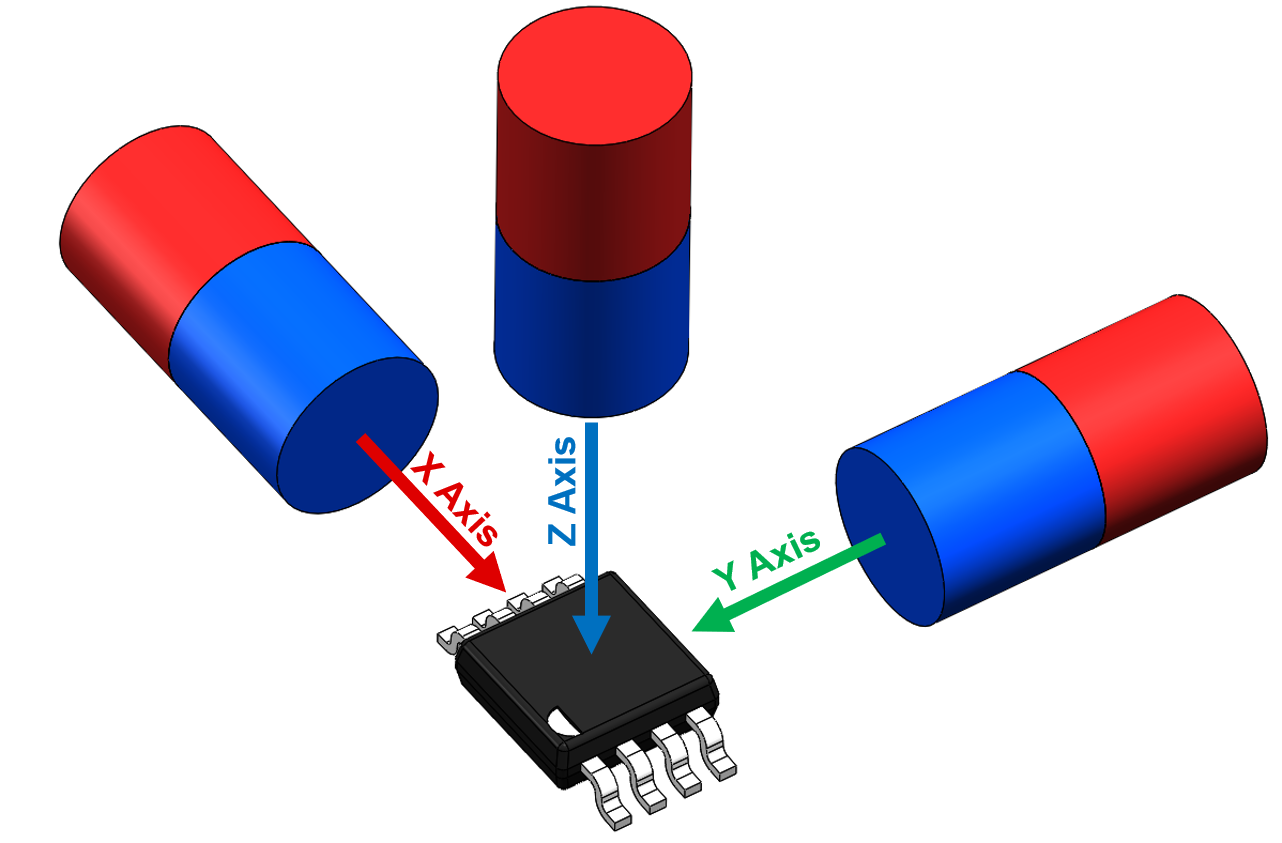SLYA076 july 2023 TMAG5273
2.3.1 Different Types of Hall-Effect Sensors
The basis of measuring a liquid with a Hall sensor is that a magnet moves along with the water level and a Hall-effect sensor measures the magnetic field from the moving magnet. Based on the measured magnetic field from the magnet, the system can determine what is the position of the magnet.
TI offers several different types of Hall-effect sensors: latches, switches, 1-axis linear, and linear 3D sensors. Linear sensors can provide detailed magnetic data since they represent the magnetic flux density using an analog voltage or a digital numeric representation that changes as the field experienced by the device changes.
The magnetic field from two directions can be obtained using two 1D sensors orthogonal with each other. Alternatively, one 2D or 3D sensor that sense magnetic fields in orthogonal axes can be used instead. Figure 2-3 shows an example mapping of the three axes of sensitivity of a linear 3D Hall-effect sensor, the TMAG5170. The mapping of the X, Y, and Z directions as well as how a positive field is defined can vary among different parts.
 Figure 2-3 3D Hall Sensor Axis
Figure 2-3 3D Hall Sensor AxisTI offers linear 3D Hall-effect sensors with different interface options, such as SPI and I2C. These sensors are listed in Table 2-1. Dual-Die sensors such as the TMA5170D-Q1 provide integrated redundancy within a single device package. This is especially important for many automotive applications.
| Device | Type | Characteristics | Design Considerations |
|---|---|---|---|
| TMAG5170and TMAG5170-Q1 | 3D Hall-Effect | Commercial & Automotive grade linear 3D Hall-effect position sensors with SPI available in 8 pin DGK package | Complete magnetic vector sensitivity. This device is able to track a wide range of magnet positions, though careful planning is still required to make sure all input conditions map to a unique position. |
| TMAG5170D-Q1 | 3D Hall-Effect | Dual-die Automotive high-precision 3D linear Hall-effect sensor with SPI available in 16-pin TSSOP package | Identical to the TMAG5170, but with stacked sensor dies for integrated redundancy. Developed for functional safety applications, with resources supporting design up to ASIL D. |
| TMAG5273 | 3D Hall-Effect | Commercial grade Linear 3D Hall-effect position sensor with I2C interface available in 6 pin SOT-23 package | Similar to the TMAG5170, but operates over I2C with wider sensitivity tolerance specifications. |
| TMAG5173-Q1 | 3D Hall-Effect | Automotive grade Linear 3D Hall-effect position sensor with I2C interface available in 6 pin SOT-23 package | Operates over I2C with improved performance over the TMAG5273. |
| TMAG6180-Q1 and TMAG6181-Q1 | 2D AMR | These devices are high-precision angle sensors based on Anisotropic Magneto Resistive (AMR) technology. The TMAG6180-Q1 has a 360° angle range, while the TMAG6181-Q1 has an integrated turns counter. | Supports both differential & single-ended Sin/Cos outputs for angular speeds up to 60,000 RPM providing an angular error <0.6 degree across temperature with no system-level calibration needed. |
Compared with a resistor-wiper implementation, Hall-effect sensors are more reliable, and they are minimally affected by environment changes like humidity, dust, or water. Hall-effect liquid level sensing implementations are not prone to the wear and tear issues of mechanical solutions, which extends the lifetime of these solutions.